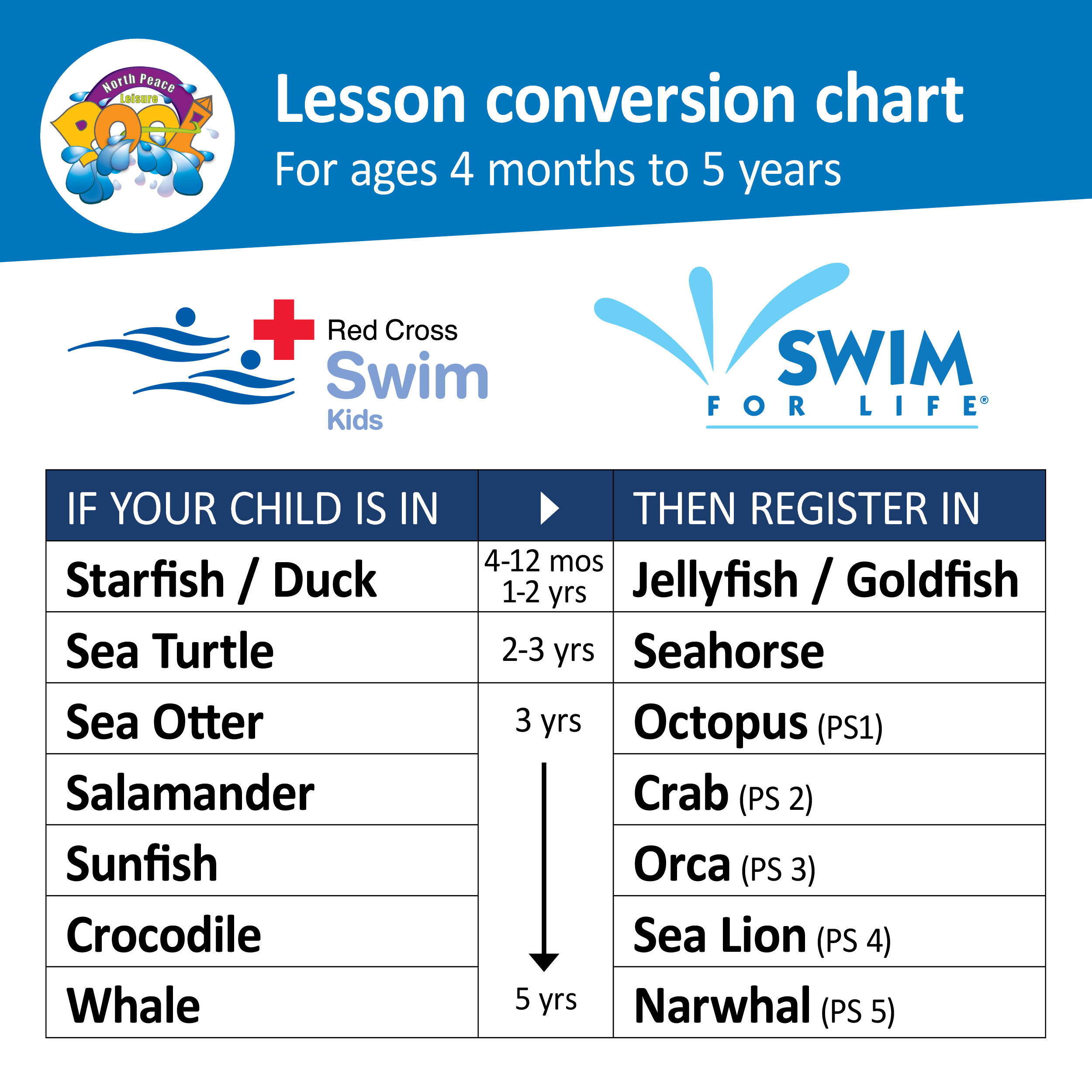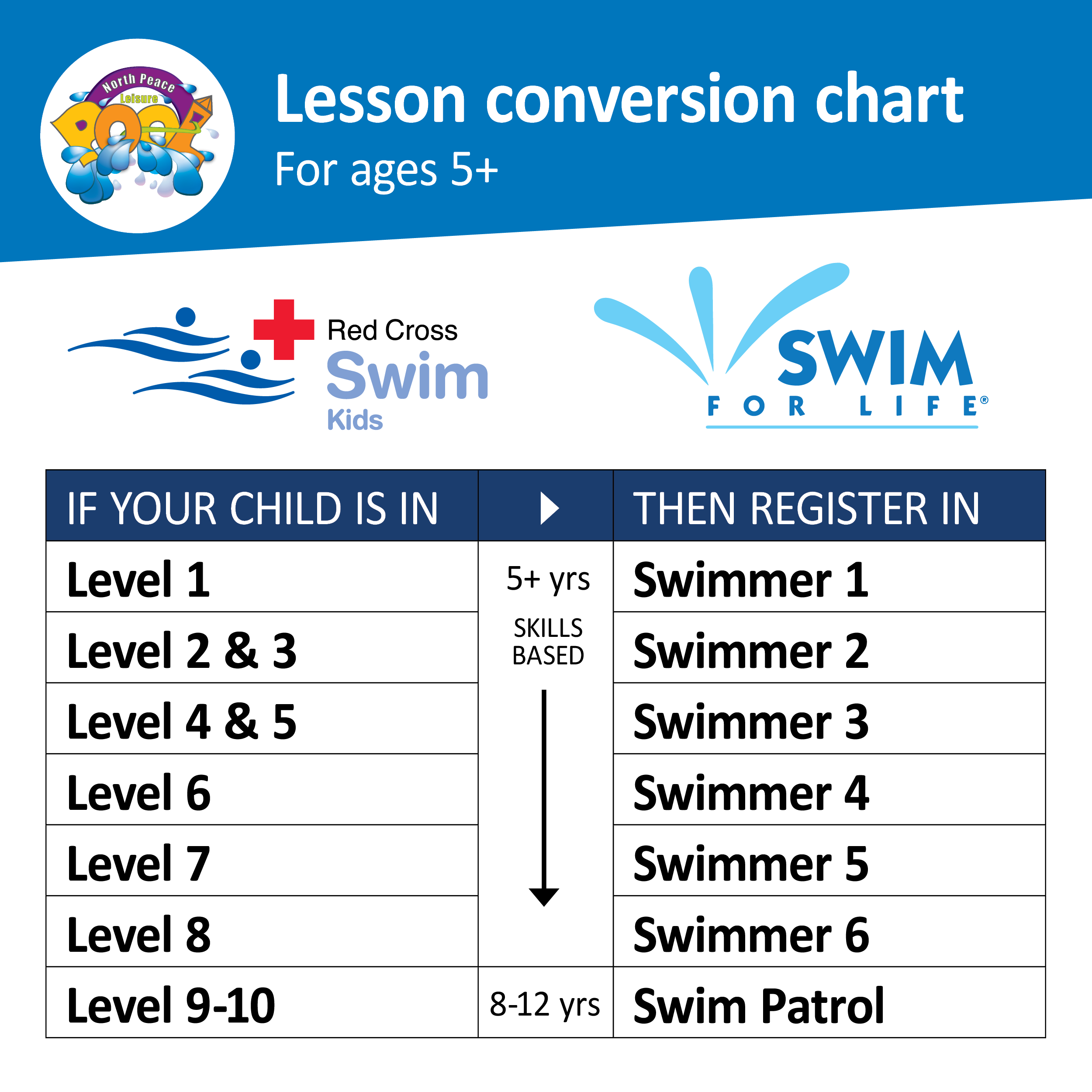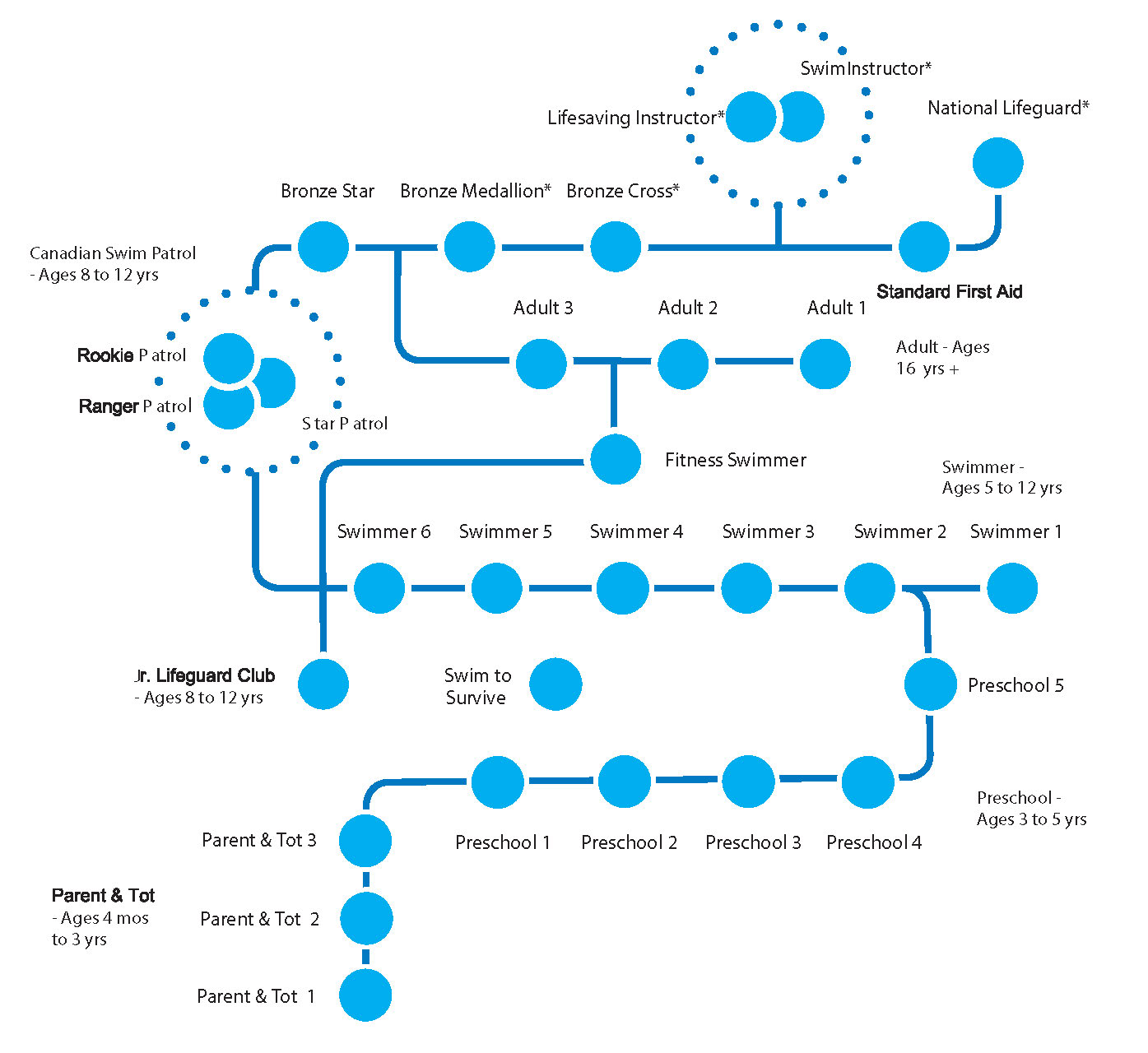Swimming Lessons
Transition to "Swim for Life"
As of January 2023, the North Peace Leisure Pool transitioned to the Lifesaving Society Canada's Swim for Life program, as the Canadian Red Cross concluded its swimming and lifeguarding programming.


About Swim for Life
Swim for Life is a complete learn-to-swim program from Parent & Tot through to Leadership. Easy to program and easy to explain, Swim for Life leads seamlessly into the Society’s lifesaving training awards. The program is endorsed by the International Life Saving Federation and the Commonwealth Royal Life Saving Society. There are five modules of the Swim for Life program:
- Parent & Tot for parents and children up to 3 years of age
- Preshool for children 4-5 years
- Swimmer for children 5 years and older
- Adult Swimmer for people over 16 years
- Fitness Swimmer for swimmers of any age who want to improve their overall physical fitness.
The Society designed the modules to flow together seamlessly and logically into one another and into the basic lifesaving awards: Rookie, Ranger and Star Patrol
Program Overview

Lesson Information
Registration is available IN PERSON, OVER THE PHONE, and ONLINE for all public sessions. If you are interested in Private Lessons, please contact the NPLP directly at 250-787-8178 or come in during front desk hours to enroll as Privates are not available for online enrollment.
PLEASE NOTE: As per our refund policy, a refund or transfer must be at least 7 days before the start of the program. Any withdrawals made with less than 7 days to the start of the program will not be eligible for a refund. All refunds are subject to a 10% administrative fee. All online transactions are subject to an online transaction convenience fee that is not issued by the North Peace Leisure Pool - this is a fee charged by ActiveNet and is not included in any refunds.
Swim for Life Level Descriptions
Parent & Tot 1/2 - Jellyfish/Goldfish (Red Cross Equivalent: Starfish/Duck)
Recommended age: 4-12 months
Teaches toddlers how to play in the water safely! Infants will be introduced to getting their face wet, blowing bubbles, and floating with the help of their parent/caregiver. Provides an orientation to water for infants and their parent/caregiver. Parents/Caregivers will learn how to swim safely with their infant in the pool through instruction of holds and supports.
Parent & Tot 3 - Seahorse (Red Cross Equivalent: Sea Turtle)
Recommended age: 2-3 years
Teaches toddlers how to safely enter the water wearing a PFD. They’ll develop underwater skills such as submersion and opening their eyes underwater. ‘Starfish’ floats, ‘pencil,’ floats, and kicking skills are taught using songs and games
Preschool 1 - Octopus (Red Cross Equivalent: Sea Otter)
Recommended age: 3-5 years
Preschool 1 is a transitional level which transfers the preschooler to the care of the instructor. Preschoolers will have fun learning to get in and out of the water. They’ll learn how to put their face in the water, blow bubbles in the water, and how to float and glide.
Preschool 2 - Crab (Red Cross Equivalent: Salamander)
Recommended: Completed Octopus
Teaches preschoolers how to safely jump into chest-deep water and how to swim wearing a PFD. They’ll learn submersion skills and continue to work on floats, glides, and kicking with buoyant objects.
Preschool 3 - Orca (Red Cross Equivalent: Sunfish)
Recommended: Completed Crab
Teaches preschoolers how to enter deep water safely wearing a PFD. They’ll learn hot to submerge and exhale underwater, retrieve objects underwater, and will continue developing their floating, gliding, and kicking skills.
Swimmer 1 (Red Cross Equivalent: Swim Kids 1)
Recommended age: 5-12 years
These beginners will become comfortable jumping into the water with and without a PFD. They’ll learn how to open their eyes, exhale, and hold their breath underwater. Floats, glides, and kicking skills are introduced.
Swimmer 2 (Red Cross Equivalent: Swim Kids 2/3)
Recommended: Completed Swimmer 1 or Preschool 5
These swimmers will jump into deeper water and learn to be comfortable falling sideways into the water wearing a PFD. They’ll learn how to tread water, develop kicking skills, and will be introduced to front crawl and back crawl.
Swimmer 3 (Red Cross Equivalent: Swim Kids 4/5)
Recommended: Completed Swimmer 2
These swimmers will learn how to dive and will do in-water somersaults and handstands to develop weight-transfer skills. They’ll learn Swim to Survive skills, whip kick on back, and will further develop their front crawl and back crawl.
Swimmer 4 (Red Cross Equivalent: Swim Kids 6)
Recommended: Completed Swimmer 3
These swimmers will become better at diving, treading water, and swimming underwater. They’ll learn the Swim to Survive standard and start to develop breaststroke. Front crawl and back crawl are further developed.
Swimmer 5 (Red Cross Equivalent: Swim Kids 7)
Recommended: Completed Swimmer 4
These swimmers will master dives and swimming in deep water. They’ll further their Swim to Survive skills and start to develop eggbeater and scissor kick. Breaststroke, front crawl, and back crawl are further developed. Interval training and sprinting drills continue to challenge these swimmers.
Swimmer 6 (Red Cross Equivalent: Swim Kids 8)
Recommended: Completed Swimmer 5
These swimmers will become proficient at deep water skills including stride entries and compact jumps. They’ll develop lifesaving kicks such as eggbeater and scissor kick. Breaststroke, front crawl, and back crawl are further developed. Head-up swims, interval training, and a 300m workout develop strength and endurance.
Swimmer 7/8/9 - Swim Patrol (Red Cross Equivalent: Swim Kids 8/9/10)
Rookie Patrol
Recommended: Completed Swimmer 6
Swimmers continue developing front crawl, back crawl, and breaststroke. Swimmers develop individual fitness to meet a timed 100m swim and a 350m workout. Water proficiency skills include swimming with clothes, ready position, and feet-first/head-first surface dives. Demonstrating the ability to conduct a primary assessment and calling EMS are included as first aid skills. Victim recognition and throwing assists are other key elements of the program.
Ranger Patrol
Recommended: Completed Swimmer 7 - Rookie Patrol
Teaches capability in the water including stride entries and underwater, forward and backward somersaults. Swimmers learn lifesaving sport skills with a lifesaving stroke medley, timed object support and a non-contact rescue with a buoyant aid. Eggbeater kick and increased fitness levels are developed to meet a 200m timed swim. First aid focuses on unconscious victims and obstructed airway procedures.
Star Patrol
Recommended: Completed Swimmer 8 Ranger Patrol
Challenges swimmers with a 300m timed swim, 600m workout, and a 25m object carry. Strokes are continued to be refined. Lifesaving skills include use of rescue aids, defense methods, victim removals, and support a victim in shallow water. First aid focuses on treatment of bone or joint injuries and respiratory emergencies. Once complete, swimmers register into Bronze Star.


